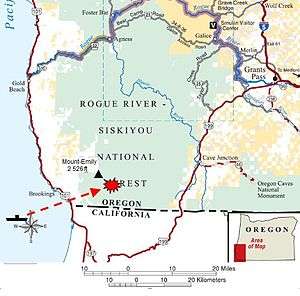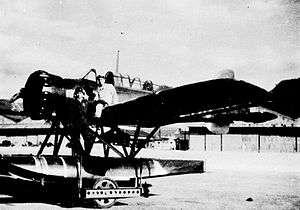Lookout Air Raids
| Lookout Air Raids | |||||||
|---|---|---|---|---|---|---|---|
| Part of World War II, Pacific War | |||||||
 Lookout air raid schema | |||||||
| |||||||
| Belligerents | |||||||
|
|
| ||||||
| Commanders and leaders | |||||||
| Keith V. Johnson |
Tagami Meiji Nobuo Fujita | ||||||
| Strength | |||||||
| 1 patrol of fire lookouts |
Sea: 1 submarine Air: 1 aircraft | ||||||


The Lookout Air Raids were minor but historic Japanese air raids that occurred in the mountains of Oregon, several miles outside Brookings during World War II.[1] This was the only time during World War II that the 48 contiguous United States suffered an air raid attack by enemy forces.
On September 9, 1942, a Japanese Yokosuka E14Y Glen floatplane, launched from a Japanese submarine, dropped two incendiary bombs with the intention of starting a forest fire. However, with the efforts of a patrol of fire lookouts[2] and weather conditions not amenable to a fire, the damage done by the attack was minor.[3] The attack was the first time the 48 contiguous United States was bombed by an enemy aircraft and the second time that the mainland US was bombed by someone working for a foreign power, the first being the bombing of Naco, Arizona by Patrick Murphy, although the Murphy bombing inside the U.S. was an accident.
Air raids
On Wednesday morning, September 9, 1942, the I-25, under the command of Lieutenant Commander Meiji Tagami, surfaced west of Cape Blanco. The submarine launched a "Glen" Yokosuka E14Y floatplane, flown by Warrant Officer Nobuo Fujita[4] and Petty Officer Okuda Shoji, with a load of two incendiary bombs of 76 kilograms (168 lb) each.[5]
Howard "Razz" Gardner spotted and reported the incoming "Glen" from his fire lookout tower on Mount Emily in the Siskiyou National Forest.
Although Razz did not see the bombing, he saw the smoke plume and reported the fire to the dispatch office. He was instructed to hike to the fire to see what suppression he could do. Dispatch also sent USFS Fire Lookout Keith V. Johnson from the nearby Bear Wallow Lookout Tower.
The two men proceeded to the location and were able to keep the fire under control. Only a few small scattered fires were started because the bombs were not dropped from the correct height. The men stayed on scene and worked through the night keeping the fires contained. In the morning, a fire crew arrived to help. A recent rain storm had kept the area wet, which helped the fire lookouts contain the blaze.
Aftermath
A full investigation was launched by the FBI, which resulted in locating several bomb fragments. The story was reported in several newspapers on September 10, 1942. Lieut. Gen. John L. DeWitt, the area commander announced,
The Western Defense Command is investigating the circumstances surrounding the discovery on Sept. 9 of fragments of what appears to have been an incendiary bomb. These fragments were found by personnel of the United States Forestry Service near Mt. Emily nine miles northeast of Brookings, Or. Markings of the bomb fragments indicated that the missile was of Japanese origin.[2]
The floatplane carried two bombs. Both were dropped, according to the Japanese records, but no trace has yet been found of the second bomb. One of the bombs left a foot-deep crater.[2] Fujita and his observer made a second attack on September 29, again causing only negligible damage.
Postwar
Twenty years later, the floatplane's pilot, Nobuo Fujita, was invited back to Brookings. Before he made the trip the Japanese government was assured he would not be tried as a war criminal. In Brookings, Fujita served as Grand Marshal for the local Azalea Festival.[1] At the festival, Fujita presented his family's 400-year-old samurai sword to the city as a symbol of regret. Fujita made a number of additional visits to Brookings, serving as an "informal ambassador of peace and friendship".[6] Impressed by his welcome in the United States, in 1985 Fujita invited three students from Brookings to Japan. During the visit of the Brookings-Harbor High School students to Japan, Fujita received a dedicatory letter from an aide of President Ronald Reagan "with admiration for your kindness and generosity". Fujita returned to Brookings in 1990, 1992, and 1995. In 1992 he planted a tree at the bomb site as a gesture of peace. In 1995, he moved the samurai sword from the Brookings City Hall into the new library's display case. He was made an honorary citizen of Brookings several days before his death on September 30, 1997, at the age of 85.[7] In October 1998, his daughter, Yoriko Asakura, buried some of Fujita's ashes at the bomb site.
See also
- American Theater (World War II)
- Amerika Bomber
- Bombardment of Fort Stevens
- Fire balloon
- Operation K
- Patrick Murphy (pilot)
References
- 1 2 Bingham, Larry (2008-10-02). "Oregon coast trail dedicated for World War II bombing". The Oregonian. Retrieved 2009-02-04.
- 1 2 3 Jap Incendiary Sets Forest Fire. DeWitt's Announcement Hints Raider May Have Been Launched From Submarine Off Coast, Later Attacked by Patrol Planes
- ↑ The Journal of military history, Volume 53, p. 172. Virginia Military Institute, American Military Institute, George C. Marshall Foundation, 1989
- ↑ CBS News. Steve Hartman. A Soldier's Story: Steve Hartman Talks To An Oregon Veteran
- ↑ Mochitsura Hashimoto (1954). Sunk.
- ↑ Burel, Patty (2008-09-19). "Trail Dedication at Japanese Bombing Site Set". FS Today. Retrieved 2011-09-07.
- ↑ Kristof, Nicholas (1997-10-03). "Nobuo Fujita, 85, Is Dead; Only Foe to Bomb America". New York Times. Retrieved 2009-03-04.
External links
| Wikimedia Commons has media related to Lookout Air Raids. |
- Los Angeles Times news story of September 15, 1942
- Trail Dedication at Japanese Bombing Site Set - U.S. Forest Service
